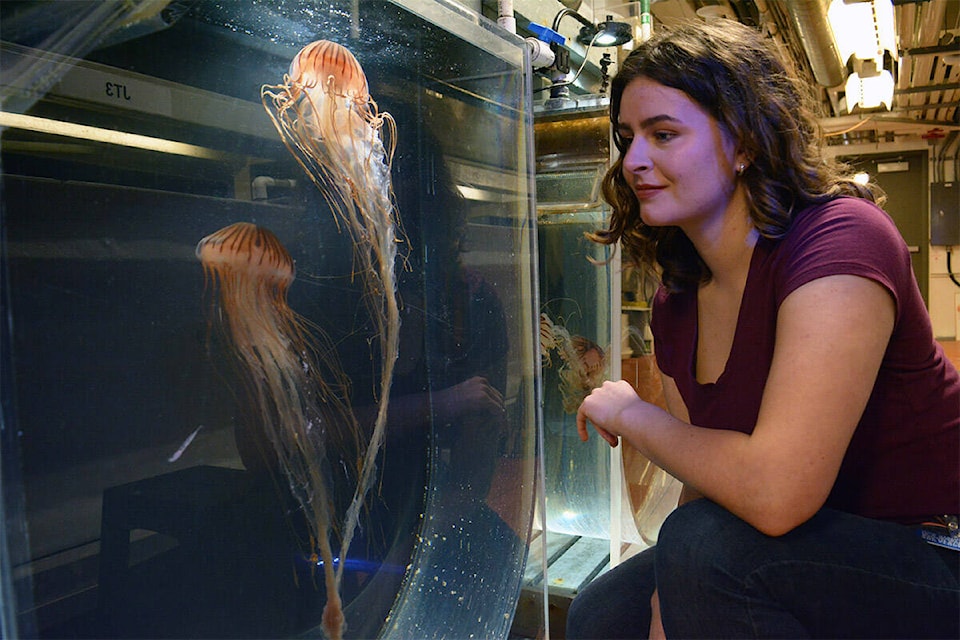University of British Columbia PhD student Jessica Schaub will depart for Japan on Wednesday (June 29), to begin the first section of an international journey studying large groups of jellyfish, known as blooms.
For more than a year, she will take to the waters of France, Argentina and Australia to observe how blooms respond to their environment — and how we respond to them.
The 26-year-old oceanographer’s four-part trip is financed by the , which will allow her to experience the ways jellyfish affect daily life across the world.
As a Metis person from Treaty Six territory, Schaub hopes her trip will show students who see themselves in her it is possible to dive into trans-national waters.
“It’s cool to be an Indigenous person who grew up in a rural area travelling the world doing jellyfish research,” said Schaub.
Although Schaub grew up landlocked in rural Alberta, she was drawn to marine biology when she was young and followed her interests to UBC.
“I always describe it as a favorite colour,” she said. “You never really know why your favourite colour is yellow, you just like it.”
When Schaub learned her application for the fellowship was successful, her now-fiancé Aria Jazdarehee took her out to a Japanese restaurant to celebrate Schaub’s first destination. The rest of Schaub’s family was also excited when they learned her application to travel the world was accepted, she said.
Jellyfish tend to cluster in dense blooms, creating a patchwork of unique ecosystems to study. Blooms can cause economic destruction.
“In the Philippines one year, jellyfish clogged the cooling intake for a power plant,” said Schaub. “So, a large portion of the islands lost power. The impact of that was equivalent to some of the typhoons in the area.”
When she arrives in Japan, Schaub will be alongside local fishers to learn about the issue of blooms weighing down their nets, making it difficult to fish. Sometimes the weight of the jellyfish can turn the boat upside down and make it fill with water.
This problem was turned into a solution in some places by establishing jellyfish fisheries. Many coastal communities in Asia have embraced a jellyfish abundance by making it a part of local cuisines.
Schaub’s observations may also help to solve some of the ongoing mysteries about jellyfish.
It is hard to know if jellyfish have always been so abundant in the areas where fishermen’s nets are weighed down, because scientists do not have long-term data on their population. However, invasive species of jellyfish are becoming a problem in areas such as the Mediterranean. This is easier to track because it disrupts the whole ecosystem.
Scientists long believed jellyfish did not have many natural predators beyond notable exceptions such as the sea turtle, because jellyfish are mostly water. However, new recent developments in genetic testing are challenging this idea, and inviting scientists like Schaub to investigate further.
“As scientists, we do not have a consensus on where jellyfish fit in the food web,” she said. “We’re realizing, actually tons of animals eat jellyfish. Now the question is more ‘why does something eat jellyfish?’”
Travelling the world and finishing a PhD adds up to a busy schedule.
After a month in Japan, Schaub will return for her studies for several months. Then, she will go to France for a month. She will then return home, before going to Argentina for three months. Her experience will be complete after she spends three weeks at the Ningaloo Reef in Exmouth, Australia.
There she will help with developing a rapid-test to detect how many tiny yet venomous jellyfish are in the waters of the popular tourist destination at a given time.
The Irukandji jellyfish are difficult to see and people have died from their stings, which makes them a hazard for people visiting the reef. The rapid-test project is led by and local government researchers.
After completing so many years of education in Canada, Schaub looks forward to broadening her horizons.
She will post updates about her journey and research on her Instagram and .



